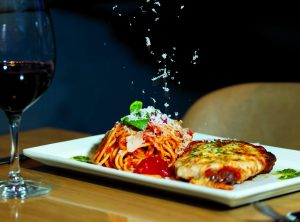Celebrating Indigenous culture
Honoring Po’ Pay displays contemporary portraits by Cara Romero and Lee Marmon at the Vilar Performing Arts Center

Dominique Taylor/ART Weekly
When curator Agnes Hsu-Tang organized the “Honoring Po’ Pay” photography exhibit at the Vilar Performing Art Center’s May Gallery, she wanted to remind viewers that America’s indigenous people and their cultures are not forgotten and will not be left behind.
“They are very much alive, and we are all part of our shared contemporary society, together,” Hsu-Tang says.
The art collector points out that photographers like Edward Curtis, whose famous image, “The Vanishing Race” depicting a staged caravan of indigenous people riding away from the viewer, conveys the message that “Indigenous North Americans belonged in the past.”
“In Lee Marmon and Cara Romero’s hands, the camera is not a weapon of the predatory gaze that romanticizes Indigenous people through stereotype,” Hsu-Tang says. “Instead, Marmon and Romero take and present ownership of Indigenous histories and cultures, and the subjects in their portraits have agency. These images are not created to fulfill a self-directed ‘savior complex’ and the people they portray are empowered, not vanishing or helpless.”
Both Native American photographers, Marmon and Romero come from different generations. Their work showcases contrasting styles and techniques.

Support Local Journalism

Marmon grew up in the Laguna Pueblo in New Mexico, fought for the U.S. in World War II and died in 2021 at age 95. He used a traditional film camera for his portraits, all of which, as Hsu-Tang points out, “are naturalistic and most of them were taken outdoors during daytime, as he preferred not to use artificial lighting for enhancement.” In addition to several portraits that have never previously been displayed in public, the Beaver Creek exhibit includes a signed poster of Marmon’s most famous piece, White Man’s Moccasins, depicting a Laguna Tribal Elder sitting stoically wearing a pair of Converse sneakers.
One of America’s most successful Indigenous artists, Romero was born in 1977 and grew up partly on the Chemehuevi reservation in California’s Mojave Desert. She lives and works in Santa Fe, NM and has used digital photography throughout her career. She visualizes the story she wants to tell before staging and photographing each piece. The May Gallery exhibit includes her most renowned work, Water Memory, (also displayed at New York’s Metropolitan Museum), depicting two figures suspended underwater.
“The viewer in Water Memory is also immersed in the water with the two human figures, and it is up to the viewer to decide whether they are all floating or drowning together,” Hsu-Tang says. “To me, this image is about our common bond as humans. Water Memory transcends the demarcations that we choose to perceive — time, space, race —and makes us think about the consequences of destruction of nature. Water has the paradoxical power to nurture and to inundate; it does not discriminate.”
The one shared approach in Marmon and Romero’s work is that their subjects are all people they know.

“These portraits, seen through the lens of two contemporary master storytellers, illuminate the vibrancy and multiplicity of contemporary Indigenous cultures,” Hsu-Tang says.
The recently renovated May Gallery now serves not only as an artistic space for specially curated exhibitions like “Honoring Po’ Pay,” but also an intimate live music venue; upcoming performances include Quatuor Debussy on March 31 and Bill Frisell Trio on April 2.
The Po’ Pay exhibit will be on display through the end of the winter season.
“I love how the images compliment the space, both individually and as the full exhibit,” says Vilar Performing Arts Center Executive Director Cameron Morgan. “The minimalism of the black and white images alongside the rich vibrancy of the color images creates a wonderful contrast and depth to the space. There is so much context, history and culture represented and captured in these images.”
What:”Honoring Po’ Pay” exhibit
Where: Vilar Performing Arts Center
Beaver Creek
More info: vilarpac.org










